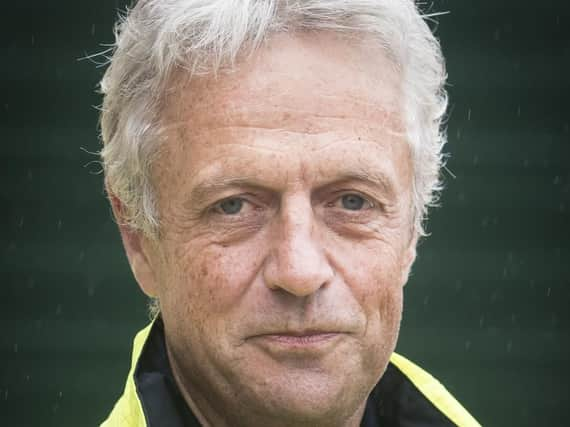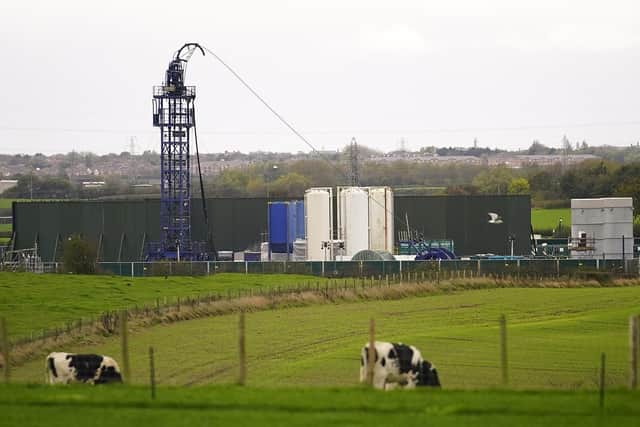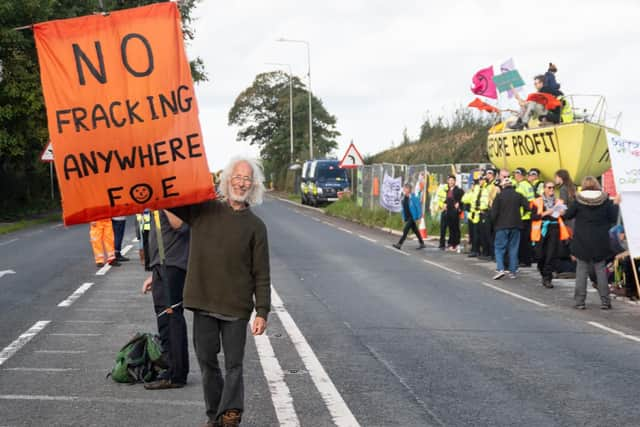Opposition continues to increase as the future of shale gas drilling in the UK is in the spotlight


In 2016, the cabinet office expected up to 20 fracked wells by mid-2020 - but only three wells have been fracked to date.
A new report from the National Audit Office has found that progress in establishing the industry in England has been slower than initially planned, while operators have said the system to protect against the risk of earthquakes is stricter than that used internationally and has hindered their development.
Advertisement
Hide AdAdvertisement
Hide AdMeanwhile, opposition to the controversial extraction process is on the rise.


MP backs calls for a ban on drilling across the UK
Blackpool South MP Gordon Marsden has seconded a Queen’s Speech amendment in Parliament to ban fracking in the UK. It comes at the same time as a critical report from the National Audit Office saying that the government had not analysed the benefits and costs on fracking and support for shale gas from the public was low.
Gordon is backing the motion by fellow North West Labour MP Faisal Rashid because it follows on from successive red-light earth tremors in August, including a record one at 2.9, which caused damage to people’s properties in Blackpool. It forced Cuadrilla to suspend drilling at Preston New Road in August until an investigation by the Oil & Gas Authority (OGA) was carried out. Gordon has written to the OGA demanding a complete ban on drilling and their investigation into the tremors to be fully independent from Government.
He said: “I have consistently campaigned for a ban on fracking, which is why we need it now on back of the Queen’s Speech and the NAO report. After the tremors in August I had dozens and dozens of people who had never previously contact me, worried and concerned about fracking. Cuadrilla have sadly proved what I said at the very start – fracking cannot be done safely.


Advertisement
Hide AdAdvertisement
Hide Ad“Lancashire County Council rejected fracking but Tory Ministers rode roughshod over them to force it on to local people. There are still too many cheerleaders in Boris Johnson’s Government for fracking – his own Secretary of State for Energy, Andrea Leadsom. It’s clear you can’t trust the Tories to ban fracking. Only the Labour Party has given that direct commitment to do that in Government.
“A report from the Government itself in 2015 also concluded that fracking increases air pollution and posed contamination risks to the local environment. We should instead be investing in renewables and high-skilled green technologies. Blackpool is in the perfect place geographically to do that become a hub for wind, tidal and solar energy. That’s why we must look at using the Enterprise Zone at Blackpool Airport to maximise some of these opportunities.
“The NAO say the Government are also not doing enough to develop the necessary technologies to meet our current climate change targets. It also raises the alarming possibility that landowners may be liable for the decommissioning costs of shale gas wells when an operator is unable to fund them. However the Environment Agency might still be unable to pursue this leaving the prospect of huge eyesores on our landscape in Lancashire and elsewhere.”
Government plans for shale gas
A report commissioned by industry and part-funded by the government forecast a £33 billion investment in shale gas development and the creation of 64,500 jobs.
Advertisement
Hide AdAdvertisement
Hide AdHowever, the Department for Business, Energy and Industrial Strategy has not conducted an independent assessment of the potential costs or benefits of supporting the shale gas industry because it believes an assessment would not be meaningful while the industry is in the exploration stage.
The cost of fracking
The Government’s Department for Business, Energy and Industrial Strategy will have spent a total of £8.4 million, excluding staff costs and expenses, on supporting shale gas between April 2012 and March 2020. Most of this expenditure has been to support environmental monitoring and research.
Since 2015, the Environment Agency has annually received £1.5m in grant-in-aid from the Department for the Environment, Food and Rural Affairs to manage the regulation of the onshore oil and gas industry, including shale gas.
A range of infrastructure, including water treatment wells and waste plants, would need to be in place to support a large-scale shale gas industry, but the government does not yet know the full costs of these developments.
Advertisement
Hide AdAdvertisement
Hide AdAnd if a well is put out of commission, it may not be the big businesses who foot the bill.
Landowners may be liable for decommissioning costs of up to £1m for failed wells if an operator is unable to pay.
The NAO report read: “Costs have been borne by government departments, regulators, local authorities and other local bodies. We have identified known costs of at least £32.7million since 2011.
“This includes £13.4 million spent by three local police forces on managing protests around shale gas sites. “Because of the uncertainty over how much shale gas can be extracted, the
Advertisement
Hide AdAdvertisement
Hide AdDepartment has not estimated how much public investment will be required to support the production of shale gas at scale.”
Cuadrilla boss Francis Egan said: “We are conscious that decommissioning costs have been raised as a concern. Cuadrilla’s financial resilience has been thoroughly tested by the regulators and we also have an excellent track record in restoring our former shale exploration sites to agricultural use.”
Police and councils
Fracking has already placed financial pressures on local bodies, including local authorities and police forces. The NAO estimates that at least £32.7million has been spent by public bodies since 2011. This includes £13.4million spent by three local police forces on in costs related to anti-fracking protests and traffic disruption.
Lancashire constabulary reported that, daily, between 25 and 100 officers were directly involved in the policing of fracking sites between January 2017 and June 2019 at a cost of £11.8million. The Home Office reimbursed £5.8million of these costs.
Earthquake thresholds
Advertisement
Hide AdAdvertisement
Hide AdOn 1 April 2011 and 27 May 2011, fracking by Cuadrilla in Lancashire resulted in earthquakes measuring 2.3 ML and 1.5 ML respectively. The operator reported that the most likely cause was the injection of fracking fluid into an unidentified fault.
In response, a report commissioned by Cuadrilla recommended that future fracking operations should be suspended if fracking-induced earthquakes reach a threshold of 1.7 ML.
In 2012, the then Department of Energy and Climate Change set the threshold at 0.5 ML.
If fracking activity triggers earthquakes of 0.5 ML or above, a ‘red light’ is triggered and operations must cease until it is determined that it is safe to continue.
Advertisement
Hide AdAdvertisement
Hide AdOperators have asked the government to revise the traffic light system and raise the 0.5 ML threshold as they argue that it is far below the levels used internationally.
They told the NOA that the current threshold hinders their ability to determine the viability of shale gas in their sites.
Regulation and the environment
Shale gas development in England is regulated by three independent bodies: the Oil and Gas Authority, the Environment Agency, and the Health and Safety Executive.
All oil and gas exploration and production present risks to the environment, including greenhouse gas emissions and groundwater pollution. For fracking, there is an additional risk of earthquakes. However, the Government is confident that the regulatory regime can manage these risks. In 2013, EA conducted a risk assessment for shale gas and concluded that the environmental risks from fracking are low.
Advertisement
Hide AdAdvertisement
Hide AdThe regulatory system mainly relies on statutory self-reporting by operators on the amount of methane in the air and groundwater and air pollution, which the NAO said presented ‘risks’.
Since 2016, EA has conducted 71 visits to four sites with shale wells, 40 visits of which were to Preston New Road. In February 2019, the authority issued Cuadrilla with a warning for breaching its permit conditions after it found that up to 6.8 tonnes of methane had been vented after the operator was unable to flare the gas.
In 2018 the independent Air Quality Expert Group published a review of air emissions from shale gas development and found that the impacts on local and regional air quality could be substantially higher than national-level impacts,
In 2012, the Royal Society and the Royal Academy of Engineering found that the risk of water contamination is very low provided shale gas extraction occurs at least 1,000 metres below the surface.
Opposition is on the rise
Advertisement
Hide AdAdvertisement
Hide AdOpposition to fracking is on the rise, according to the Department for Business, Energy and Industrial Strategy’s attitudes survey. Some 20 per cent of people opposed the controversial process in 2013 - compared to 40 per cent in 2019.
Public concern has centred on the risks to the environment and public health, fracking-induced earthquakes, and the adequacy of the environmental regulations in place.
Cuadrilla
A spokesman for shale gas exploration operator Cuadrilla said the company believes that the National Audit Office report provides ‘a balanced overview of the industry’.
Francis Egan, Cuadrilla CEO, said: “The report clearly sets out the ongoing need for natural gas in the UK to 2050 and beyond and points to the roadmap from the Committee on Climate Change demonstrating how this can be compatible with our Net Zero 2050 target. It is also very clear about the stringent regulatory regime we operate under to ensure that no harm comes to the environment or our local communities.
Advertisement
Hide AdAdvertisement
Hide Ad“Cuadrilla is currently flow testing its second horizontal shale gas well at the UK’s flagship hydraulic fracturing site, the results of which will be shared once completed. Everything we have seen thus far reinforces our belief that high quality natural gas produced locally from UK shale can and should be a more attractive proposition economically, environmentally and from an energy security perspective than reliance on ever increasing gas imports.
“We are committed to exploring for shale gas with the aim to establish a domestic energy supply that the UK really needs. The Bowland Shale as a whole could be a very important resource for Lancashire and the UK and we plan to continue with our work to prove this.”
Friends of the Earth
Jamie Peters, fracking campaigner at Friends of the Earth, said: “This is a quietly critical report that doesn’t give the fracking industry any revived sense of hope.
“The NAO have several concerns including the mark-your-own-homework approach to regulation and the lack of clarity over who should be responsible for clean-up costs if fracking ever got going.
“Nothing has changed: fracking isn’t wanted, it’s a failed industry, and the future is renewables and energy saving.”